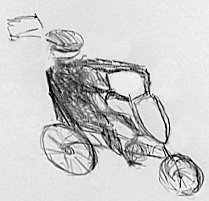By Larry Copeland, USA TODAY
Published: 3/18/2012 7:38:11 PM
SMYRNA, Ga. – The Silver Comet Trail, a 61-mile converted railroad track that slices through northwest Georgia to the Alabama border, teems with traffic this time of year from bicyclists, walkers, joggers, inline skaters and parents pushing baby carriages.
Out here, thoughts of the gasoline pump are far away — but this popular trail, which opened in 1998 and is part of the nation's longest paved recreational trail, was developed with the help of more than $3.7 million in federal matching funds that came from the federal gasoline tax.
Now, as many Americans consider bicycles in place of cars in the face of soaring gasoline prices, cyclists and nature lovers are fighting to make sure funds for trails such as this are available. And they're enjoying a growth in political clout and becoming a viable force in the national conversation on transportation.
During debate over a long-awaited federal transportation funding bill, passed last week by the Senate and pending in the House of Representatives, some members of Congress sought to strip from the bill matching funds for projects such as biking trails and walking paths. Bicyclists and recreation advocates around the nation rallied, writing, calling and e-mailing their senators and representatives.
The funding, which makes up about 1.5% of the total appropriation, remained in the Senate version. Now, cyclists and recreation advocates are working to keep it in the bill being considered in the House.
"There was a lot of anxiety about it," says Andy Clarke, president of the League of American Bicyclists, a 132-year-old, non-profit group with 20,000 members and 300,000 associated bicyclists around the USA.
"People at the local level see the connection between these projects and their health bill, or congestion, or having other choices," he says. "It's this connection that folks in Congress who want to do away these programs don't seem to have made."
Starting Tuesday, the league has its annual National Bike Summit in Washington. Many of the 800 or so members who attend will lobby House members to retain funding for projects that are usually popular in many communities. Among the trails built or maintained partly with federal transportation matching grants: the Trail of the Coeur d'Alenes in Idaho, the George S. Mickelson Trail in South Dakota, the Minuteman Bikeway in Massachusetts and the Metropolitan Branch Trail in Washington, D.C.
"It wasn't just bicyclists," Clarke says. "This really has touched a nerve with a lot of people. They spoke up. They engaged in the democratic process."
The push to encourage and develop bicycle and pedestrian paths — and cycling at a time of high pump prices — isn't confined to Washington. Among recent developments in states:
•The Florida Legislature just passed a package of biking and pedestrian initiatives that allow the sale of trail sponsorship and naming. That's designed to help save the jobs of those who maintain trails around the state. The legislation also would revoke a law that restricts cyclists to bicycling lanes even when it's dangerous and let cyclists install required lights instead of facing a fine.
•Delaware's first-term governor, Democrat Jack Markell, is an avid cyclist who proposed $13 million in his State of the State speech for a series of interlocked trails and pathways across his state. The goals are to give people more opportunities to bike, run, walk and exercise, and to attract tourism.
The state has also adopted a "Complete Streets" policy that aims for roads to be designed not just for cars, but for all users. Last year, the state committed $5 million to its biking and walking infrastructure, and for the first time spent federal Congestion Mitigation and Air Quality funds on bike-pedestrian projects. It all helps "give people a chance to manage their own health and wellness," says Brian Selander, an adviser to the governor.
•North Carolina, which has a 3,000-mile state bike road system, last week sought proposals for a Comprehensive Bicycle and Pedestrian Transportation Plan, which will include ways to improve trail safety, educate motorists and assess how trails affect business recruitment and retention.
Advocates say these states — and Washington, Minnesota, Oregon and Massachusetts, which have encouraged and developed bicycle and pedestrian paths and policies —are the exception rather than the rule. Most states focus more on building roads for motor vehicles than trails for cyclists, Clarke says.
Bicyclists could see their clout continue to grow just as the price of gasoline rises. On Friday, the average national price for a gallon of regular gasoline was $3.83, according to AAA. The last time gasoline prices spiked that high, in 2008, bicycle ridership rose so high there was a shortage of some types of bike tires.
Monday, March 19, 2012
Subscribe to:
Post Comments (Atom)




No comments:
Post a Comment